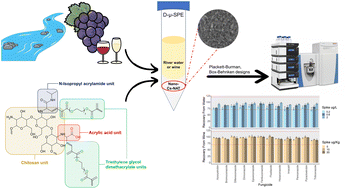Synthesis and evaluation of a chitosan nanomaterial as efficient sorbent for determination of fungicide residues in waters and wine by liquid chromatography high resolution mass spectrometry†
Abstract
In the present study a novel, cost-effective, environmentally friendly, and efficient analytical method was developed to analyze fungicide residues in water and wine. The method relies on the application of a newly developed sorbent nanomaterial named Nano-Cs-NAT, synthesized by modifying chitosan, a naturally occurring, low-cost polysaccharide, through grafting with two acrylic monomers and a cross-linker. Nano-Cs-NAT was introduced as analytical sorbent for Dispersive Micro Solid Phase Extraction (D-μ-SPE) before Liquid Chromatography-Orbitrap High-Resolution Mass Spectrometry (LC-Orbitrap HRMS) analysis of twelve fungicides commonly used in viticulture (among the others, triazoles, strobilurines and N-substituted imidazoles). Characterization of the sorbent was conducted, confirming the successful acrylation of chitosan. A multivariate approach was employed to optimize D-μ-SPE extraction parameters. The material was found to be highly effective in simultaneously purifying and concentrating the target analytes, enhancing overall analytical efficiency and sensitivity. The Nano-Cs-NAT-D-μ-SPE-LC-Orbitrap-HRMS method was thoroughly validated, exhibiting good recoveries (72–104%), reproducibility (average RSD ≤ 6%) and repeatability (average RSD ≤ 7%). It also achieved low limits of detection (LOD) in river water (average LOD of 0.04 μg L−1) and wine (average LOD of 0.72 μg kg−1), highlighting its potential for routine fungicide residue analysis. This developed method addresses environmental and food safety concerns by providing an efficient solution for detecting fungicide residues in waters and wine.



 Please wait while we load your content...
Please wait while we load your content...